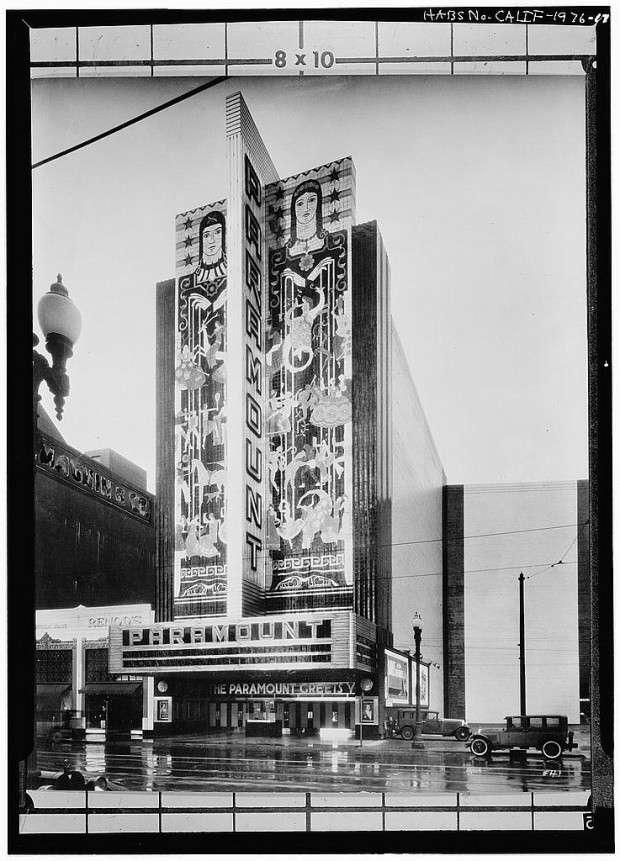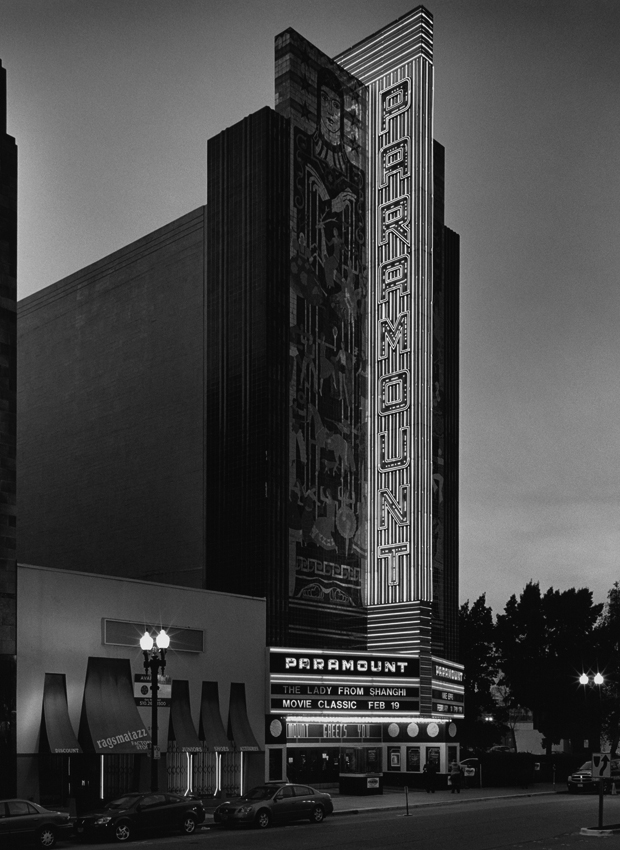An iconographic and text archive related to communication, technology and art.
☛ David Fenton: “Paramount Theatre, Oakland, 2010” by David Fenton, from the Oakland series. © David Fenton. Used with permission.
(It is worth noting that the photographer David Fenton of davidfenton.com, featured here, is not the same as the former photojournalist David Fenton of fenton.com. The later, one generation older, is the founder and CEO of a public relation firm Fenton Communications.)
The wide tonal range exhibited in this photo reminded me of the architectural photography of Karl Hugo Schmölz (previously: Karl Hugo Schmölz ― Cologne. Architectural photography of the fifties). In his book on photography, The Nature of Photographs, Stephen Shore wrote:
The tonal range of a black-and-white print is affected by the type of emulsion the print is made with. The composition of the film emulsion, the chemistry of the film and print developers, and the nature of the light source from which the print is made also determine the way shadows, mid tones, and highlights are described by the print; they determine how many shades of gray the print contains and whether these tones are compressed or separated1. (Baltimore: The John Hopkins University Press, 1998, p. 8)
David Fenton generously shared by email some details about the context in which the “Paramount Theatre” photo was taken. The whole Oakland series was commissioned by a client. The idea was to capture area landmarks in black and white. Shooting with Kodak Tri-X film, Fenton produced 45 images photographs which were printed on fiber. The ten images from the Oakland series displayed on the photographer’s website ―including the one shown above― are all digital scans of those final prints. “Not many assignments like that these days”, commented David Fenton in his email.
• • •
Oakland’s Paramount Theatre isn’t just any kind of theatre. It was designed by architect Timothy L. Pflueger and completed in 1931, it is considered today “one of the finest Art Deco movie palaces in the United-States” (An Everyday Modernism by Marc Treib, University of California Press, 1999, p. 211)
Pflueger went on to design many more motion-picture houses, many with noticeable art deco façades. The SFMOMA has a collection of his sketches. Photos of the other movie theatres he designed can be found at Cinema Treasures. Therese Poletti told the detailed story of Oakland’s Paramount Theatre design and construction in her book Art Deco San Francisco: The Architecture of Timothy Pflueger:
As he did in his other theatres, Pflueger adopted a megaphone shape for the auditorium, a sloping floor, and a massive balcony over the rear of the orchestra section. […] The theatre had seats for thirty-six hundred people, and the grand lobby could accommodate about fifteen hundred people. Plans included lounges, restrooms, separate smoking rooms for men and women, and backstage facilities with a massive rope and pulley system for stage sets. An ultramodern projection booth would be equipped with the latest in film projectors. (Princeton Architectural Press, 2008, pp. 105-126)
Back in the early 1930’s an “ultramodern” projection booth most likely would have included ―among other things― one of the early movie sound systems. At that time, the motion picture industry was just starting its transition from silent films to “talking pictures”.
Oakland’s Paramount Theatre was restored in 1973 and registered in the National Register of Historic Places the same year. The entry in the National Historic Landmark System (no. 73000395) offers both a text document (PDF / mirror) and a document with photos (PDF / mirror) which can be found through the program’s database Focus (look for “Paramount Theatre” in Oakland, California). Under the “Statement of Significance” the document reads (in part):
The Oakland Paramount Theatre is one of the two great Art Deco movie palaces left in America (with Radio City Music Hall). Built during the Depression and opened in December 1931, it was the largest auditorium seating 3,476 on the West Coast; it was recently magnificently refurbished for two-million dollar rather than a projected thirteen-million dollar cultural center.
Interestingly, the photos included in the National Register were provided by the Library of Congress’s renowned Historic American Buildings Survey. Furthermore, the photos were taken by none other than HABS Chief Photographer Jack E. Boucher, who passed away almost a year ago, in September 2012 (previously here).
The HABS has 42 entries for this single building (interior and exterior). Among those items is a photo of the theatre taken in 1932, less than a year after its completion. In fact, the image conserved at The Library of Congress is a photocopy of a photograph which originally belong in the files of Milton T. Pflueger, the younger brother of Timothy L. Pflueger.

• • •
1. Shore goes on to provide an example in the form of an untitled, undated photograph by Richard Benson which shows the bucket of an excavator on a construction site:

This reproduction of a print by Richard Benson has an exceptionally long tonal scale with subtle, clear, beautiful separation of the low values. The original print is acrylic paint applied to aluminium. It was produced from eight halftone seprations made from the original negative. (The Nature of Protographs, Baltimore: The John Hopkins University Press, 1998, p. 8)
Benson is the author of The Printed Picture, which was published by the MoMA in 2008. The material for the book was also made into an exhibition. It can still be explored online. In 1986, Benson was the recipient of a MacArthur Foundation fellowship. He was profiled in the December 17, 1990 edition of The New Yorker: “A Single Person Making A Single Thing” by Calvin Tomkins, pp. 48-71. ↩︎︎
- By Philippe Theophanidis
- on
- ― Published in Architecture, Art, Photography
- Tagged: art deco, building, California, city, movie theatre, spectacle, theatre, United-States

